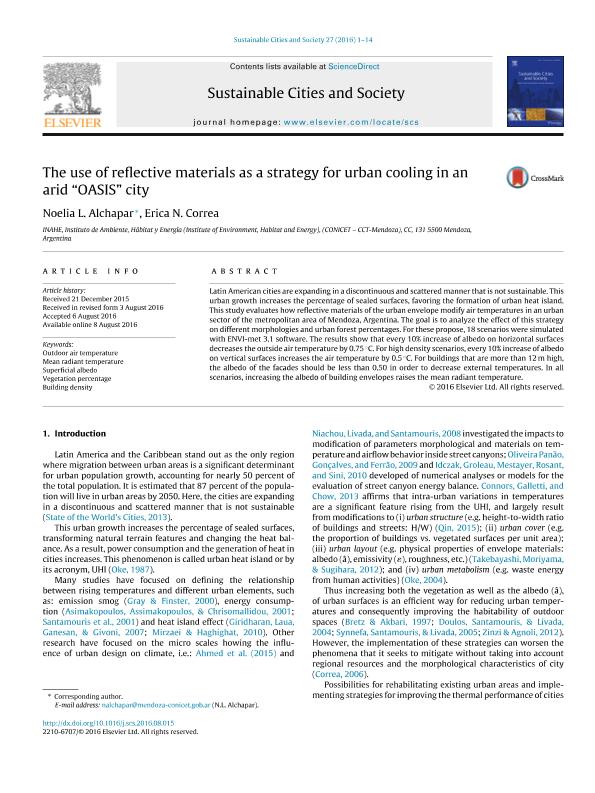Mostrar el registro sencillo del ítem
dc.contributor.author
Alchapar, Noelia Liliana

dc.contributor.author
Correa Cantaloube, Erica Norma

dc.date.available
2018-03-27T16:33:26Z
dc.date.issued
2016-11
dc.identifier.citation
Alchapar, Noelia Liliana; Correa Cantaloube, Erica Norma; The use of reflective materials as a strategy for urban cooling in an arid “OASIS” city; Elsevier Ltd; Sustainable Cities and Society; 27; 11-2016; 1-14
dc.identifier.issn
2210-6707
dc.identifier.uri
http://hdl.handle.net/11336/40161
dc.description.abstract
Latin American cities are expanding in a discontinuous and scattered manner that is not sustainable. This urban growth increases the percentage of sealed surfaces, favoring the formation of urban heat island. This study evaluates how reflective materials of the urban envelope modify air temperatures in an urban sector of the metropolitan area of Mendoza, Argentina. The goal is to analyze the effect of this strategy on different morphologies and urban forest percentages. For these propose, 18 scenarios were simulated with ENVI-met 3.1 software. The results show that every 10% increase of albedo on horizontal surfaces decreases the outside air temperature by 0.75 °C. For high density scenarios, every 10% increase of albedo on vertical surfaces increases the air temperature by 0.5 °C. For buildings that are more than 12 m high, the albedo of the facades should be less than 0.50 in order to decrease external temperatures. In all scenarios, increasing the albedo of building envelopes raises the mean radiant temperature.
dc.format
application/pdf
dc.language.iso
eng
dc.publisher
Elsevier Ltd
dc.rights
info:eu-repo/semantics/openAccess
dc.rights.uri
https://creativecommons.org/licenses/by-nc-sa/2.5/ar/
dc.subject
Building Density
dc.subject
Mean Radiant Temperature
dc.subject
Outdoor Air Temperature
dc.subject
Superficial Albedo
dc.subject
Vegetation Percentage
dc.subject.classification
Ingeniería Medioambiental y Geológica, Geotécnicas

dc.subject.classification
Ingeniería del Medio Ambiente

dc.subject.classification
INGENIERÍAS Y TECNOLOGÍAS

dc.subject.classification
Otras Ingeniería Civil

dc.subject.classification
Ingeniería Civil

dc.subject.classification
INGENIERÍAS Y TECNOLOGÍAS

dc.subject.classification
Recubrimientos y Películas

dc.subject.classification
Ingeniería de los Materiales

dc.subject.classification
INGENIERÍAS Y TECNOLOGÍAS

dc.title
The use of reflective materials as a strategy for urban cooling in an arid “OASIS” city
dc.type
info:eu-repo/semantics/article
dc.type
info:ar-repo/semantics/artículo
dc.type
info:eu-repo/semantics/publishedVersion
dc.date.updated
2018-03-27T13:38:52Z
dc.journal.volume
27
dc.journal.pagination
1-14
dc.journal.pais
Países Bajos

dc.journal.ciudad
Amsterdam
dc.description.fil
Fil: Alchapar, Noelia Liliana. Consejo Nacional de Investigaciones Científicas y Técnicas. Centro Científico Tecnológico Conicet - Mendoza. Instituto de Ambiente, Hábitat y Energía; Argentina
dc.description.fil
Fil: Correa Cantaloube, Erica Norma. Consejo Nacional de Investigaciones Científicas y Técnicas. Centro Científico Tecnológico Conicet - Mendoza. Instituto de Ambiente, Habitat y Energia.; Argentina
dc.journal.title
Sustainable Cities and Society
dc.relation.alternativeid
info:eu-repo/semantics/altIdentifier/doi/http://dx.doi.org/10.1016/j.scs.2016.08.015
dc.relation.alternativeid
info:eu-repo/semantics/altIdentifier/url/https://www.sciencedirect.com/science/article/pii/S2210670716302256
Archivos asociados
